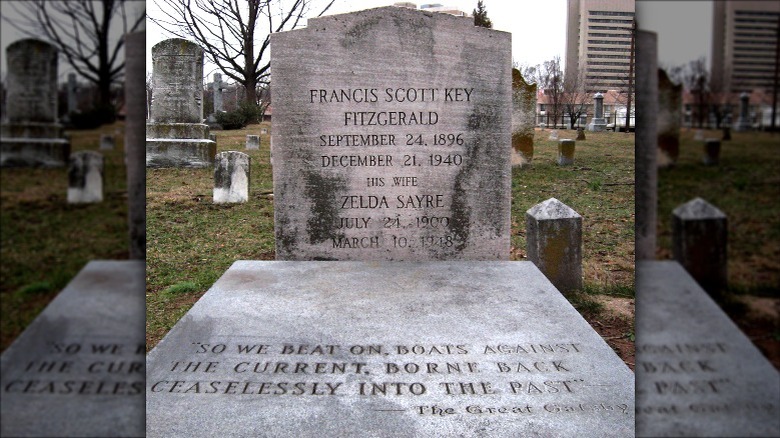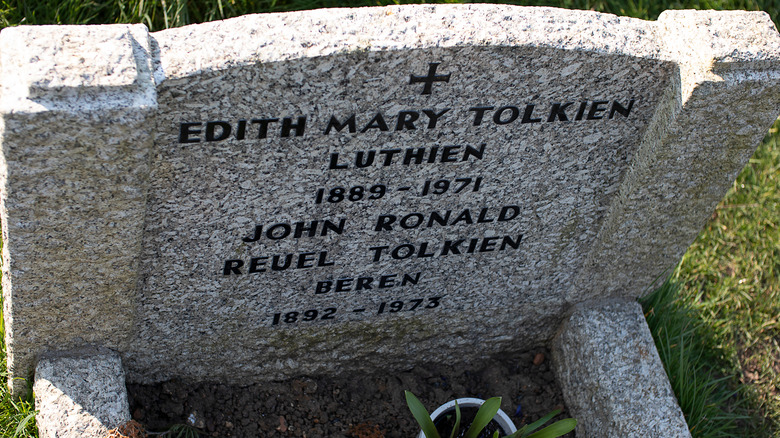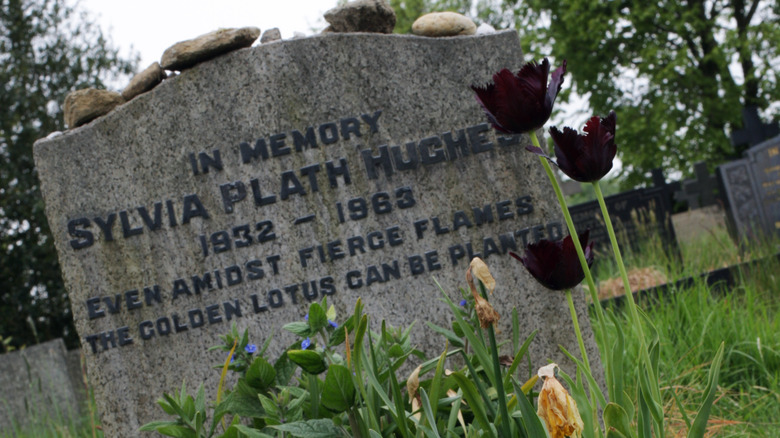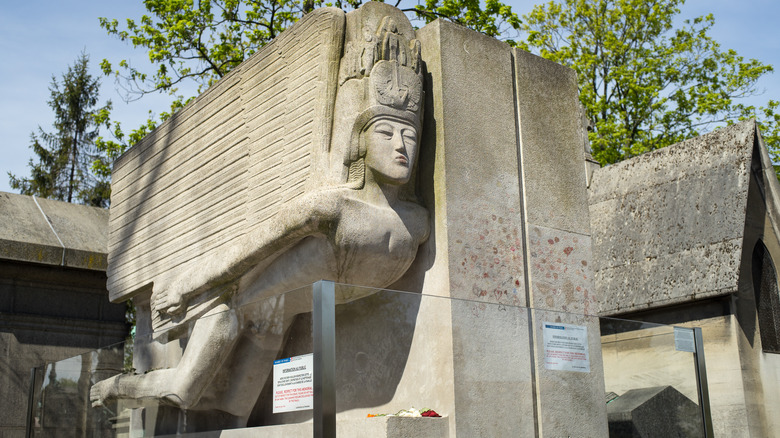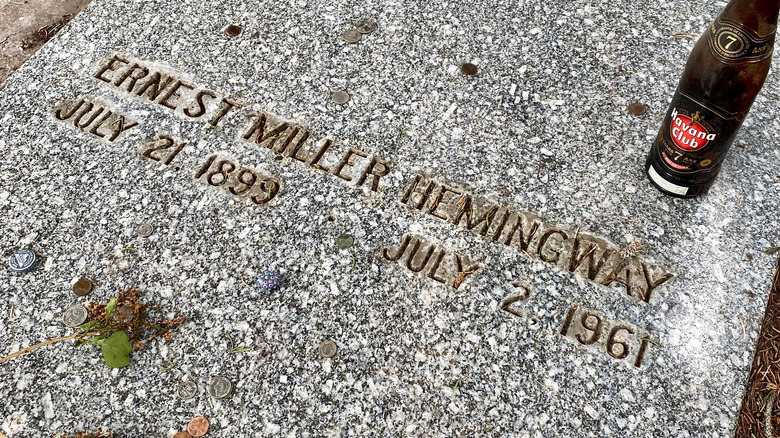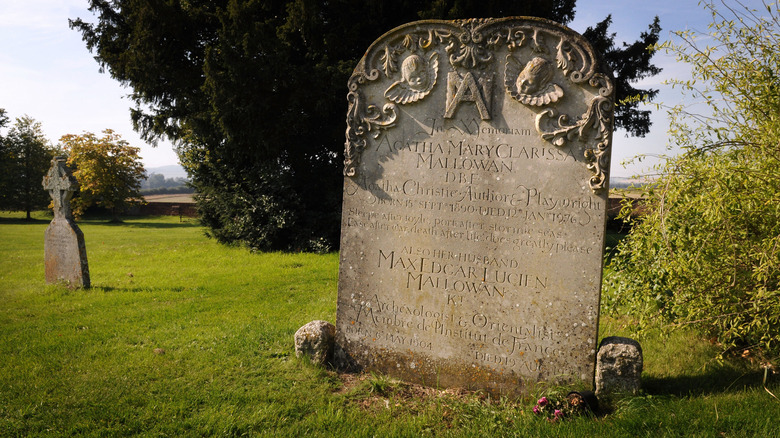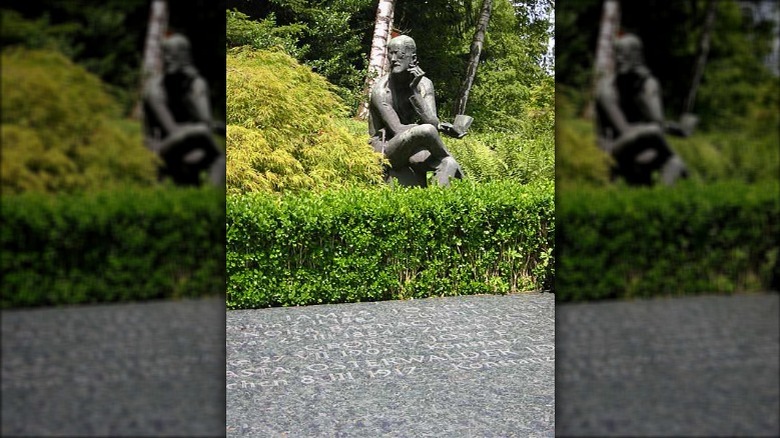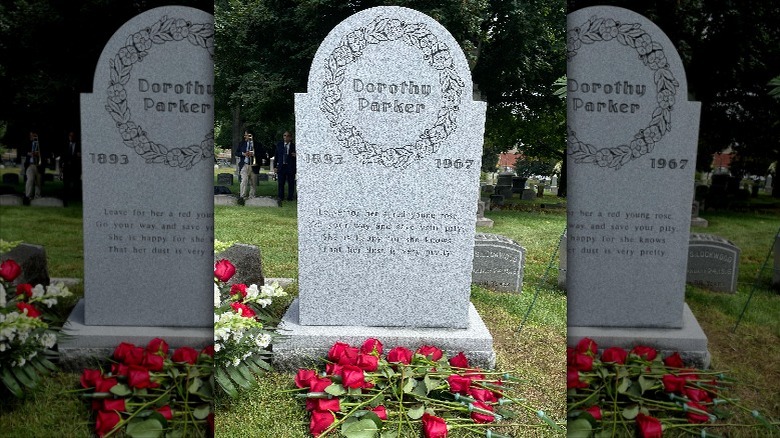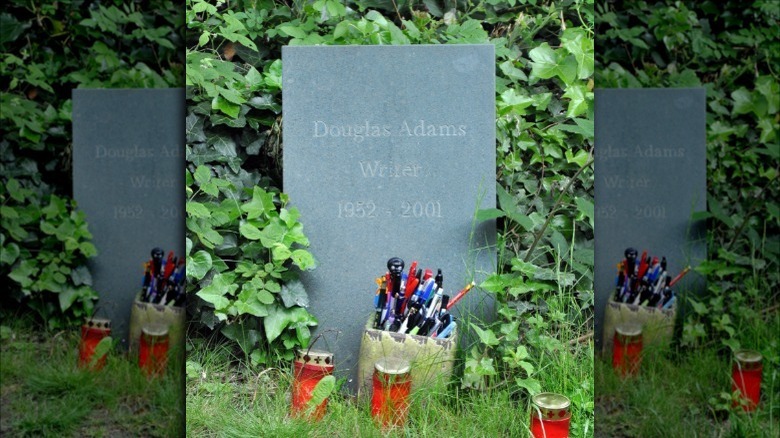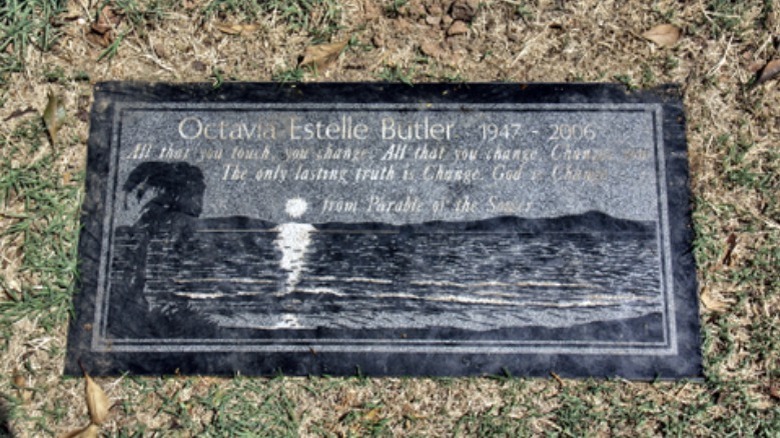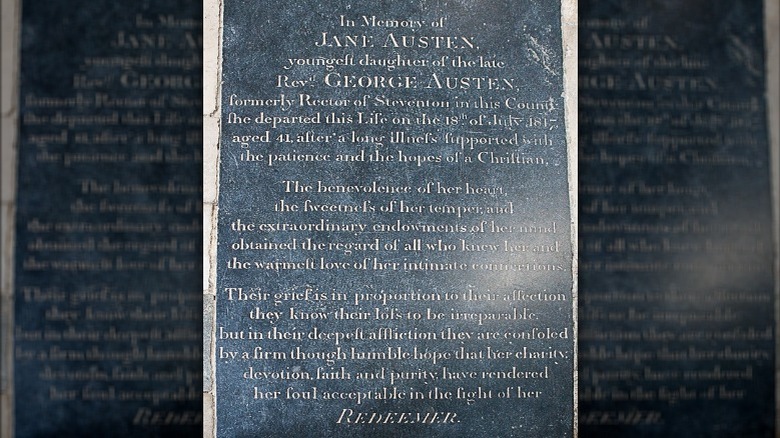Where These Famous Writers Are Buried
Literature is powerful. Books, stories, poems, and plays are so powerful they reach across the centuries and touch people who weren't alive when the work was first published. It's a form of time travel. You can open up a copy of the Catiline Orations or Samuel Pepys' diary and suddenly you're privy to the thoughts of someone who lived long ago, in a world you wouldn't recognize. And yet we're able to connect with these writers and understand their lives.
So it's little wonder that many people become a bit obsessed with great writers, and the places that loomed large in their lives and inspired their work fascinate their fans even after they're gone. That includes their final resting place. Graves have always held strong symbolic power for the living, and when the grave is occupied by a brilliant writer whose work has affected our lives, that fascination gets amplified. People make pilgrimages to writers' graves, they leave keepsakes and offerings, and they interact with the grave markers in surprising ways.
The graves of some famous writers are interesting not just because of their famous occupants, but for other reasons. Some have interesting markers, others are surprisingly simple but have complex stories behind them. Twelve writers in particular are at eternal rest in fascinating places. Here are where these famous writers are buried.
F. Scott Fitzgerald
F. Scott Fitzgerald conjurs up images of Jazz Age tragedy. Fitzgerald and his wife, Zelda, defined the "Roaring Twenties." As noted by The Washingtonian, they were literary superstars who lived a fast New York life that involved a lot of alcohol and fabulous parties. But Fitzgerald's star faded—"The Great Gatsby," now recognized as a classic, didn't do well when first released. Zelda's mental health declined, Fitzgerald's drinking increased, and he passed away at 44 convinced he was a failure.
Surprisingly, Fitzgerald and Zelda aren't buried in New York or his native Minnesota, but in Maryland. As explained by The Washington Post, Fitzgerald's full name was actually "Francis Scott Key Fitzgerald," making his connection to the Key family of Rockville, Maryland obvious. He was, in fact, a distant cousin of Francis Scott Key, the man who composed "The Star-Spangled Banner." Fitzgerald was buried in a family plot at St. Mary's Catholic Church.
As noted by Atlas Obscura, the Fitzgeralds were not wealthy despite their literary fame. When Zelda passed away 12 years later, Fitzgerald's grave was deepened and her coffin was placed on top of his—because she had only paid for a single grave. A marker wasn't installed for several more years, but one now bears the famous final line of Fitzgerald's greatest work: "So we beat on, boats against the current, borne back ceaselessly into the past."
J.R.R. Tolkien
It's no surprise that the grave of John Ronald Reuel Tolkien is a popular site for fans of his classic epic fantasy "The Lord of the Rings." As noted by Atlas Obscura, Tolkien's grave in Wolverton Cemetery in Oxford is typically festooned with flowers and other gifts from the many people whose lives have been touched by the man's work. In fact, according to An Oxford Historian, the gravesite is so popular the cemetery has placed helpful signs on the grounds to help visitors locate it.
Tolkien's wife, Edith, is buried there with him. A touching detail reported by The Los Angeles Times is the fact their gravestone calls Edith "Lúthien" and Tolkien "Beren." Those are the names of characters from one of Tolkien's stories (later expanded by his son, Christopher), the tale of a romance between a man and an elf. Mortal Beren cuts a Silmaril (a gem containing heavenly light) from dark lord Morgoth's crown as a bride price to marry the immortal Lúthien, and later becomes the only man to return from the dead due to his love for her. It's a story Tolkien revised many times, but the core love story always remained.
In other words, Tolkien's grave may not impress those looking for fantasy sculptures or references to Middle Earth, but it contains one of the simplest and most romantic inscriptions you'll ever see.
Sylvia Plath
Sylvia Plath is unfortunately remembered for her depression and suicide as much as her writing. And as noted by Slate, as Plath grew into a posthumous feminist icon, her estranged husband, writer Ted Hughes, became a villain in many people's eyes. His cruelty and indifference towards Plath as their relationship crumbled seemed to many to be directly responsible for Plath's declining mental health and eventual death.
The American Plath died in England and is buried at St. Thomas à Beckett Churchyard, Heptonstall, West Yorkshire, England, according to Literary Hub. Depending on when you go, you might have some trouble locating her grave. Plath's fans are known to chisel the name "Hughes" off of the gravestone on a regular basis—in fact, the Los Angeles Times reports that the stone has even been removed entirely in the past. In many photos of the gravestone, you can see clearly that the "Hughes" part is blurred from continuous vandalism.
Plath's legend remains a strong pull—in 2021, a 44-year-old woman petitioned to be buried near the poet (which would require special permission, as local law restricts burials to locals and members of the church). Her request was approved, as the presiding judge wasn't worried about setting a precedent that would see hordes of poetry fans applying for burial spots.
If you or anyone you know is having suicidal thoughts, please call the National Suicide Prevention Lifeline at 1-800-273-TALK (8255).
Oscar Wilde
Oscar Wilde's brilliant life and tragic end have made him an iconic writer. Prosecuted for "gross indecency"—a not-subtle code for "homosexuality"—in 1895, his trial and imprisonment essentially broke his spirit. Once one of the wittiest and smartest writers working in the English language, Wilde emerged from prison a pale reflection of his former self and died shortly after his release in 1900.
His grave in Père Lachaise Cemetery in Paris is one of the most famous in the world. As reported by The Guardian, sculptor Jacob Epstein was commissioned to create the unique modernist tomb. The huge monument makes it very easy to find Wilde's grave, and as noted by Literary Hub, Wilde's fans have taken advantage of that fact for years by kissing the tomb and leaving red lipstick behind. The Guardian notes that this morphed into all manner of red graffiti, including red hearts and written messages. In fact, this gentle vandalism got so bad that Wilde's descendants began to worry about the erosion and damage these acts of devotion were causing (the monument had also been vandalized more severely in the 1960s when someone broke off a piece). They eventually had a barrier erected to keep people away from the sculpture. Wilde's family admitted it might not stop the most determined fans, but they hoped it would at least reduce the wear and tear.
Ernest Hemingway
Ernest Hemingway's grave matches his literary style: Simple and unadorned. As noted by Esquire, the grave is a flat granite slab set under two pine trees in Ketchum Cemetery in Ketchum, Idaho. It's located not far from the house where Hemingway tragically took his own life on July 2, 1961.
Literary Hub reports that according to Hemingway's brother, Leicester, the Hemingway family purchased six lots at the cemetery for $25 apiece. "Papa" is surrounded by old friends and family—a hunting friend named Taylor Williams, his granddaughter Margot, and his fourth wife, Mary, are all buried nearby. According to Atlas Obscura, people still make the pilgrimage to Ketchum in order to leave tributes to the author in the form of coins, bottles of liquor, and flowers. Sometimes these tributes turn a bit macabre in the form of bullets left inside shot glasses.
Hemingway was very ill towards the end of his life, traveling to the Mayo Clinic regularly for treatment. Depressed and paranoid, he rarely left his house in his final days. Hemingway's father, brother, and sister had all died by suicide—after his father's death, Hemingway said, "I'll probably go the same way," and he was true to his word. The funeral was a simple affair, and the gravestone is eerily plain, bearing just his name and the dates of his life.
If you or anyone you know is having suicidal thoughts, please call the National Suicide Prevention Lifeline at 1-800-273-TALK (8255).
Agatha Christie
Agatha Christie remains one of the most famous—and best-selling—authors in the world long after her death. Book Riot notes that she's sold more than 1 billion copies of her books. Many of her 66 novels continue to be adapted into new TV series and films. Christie remains a household name more than 45 years after her death in 1976.
According to BBC News, Christie lived with her second husband Sir Max Mallowan at Winterbrook House in Wallingford from 1934 until her death at age 86. She attended church services at St Mary's Church in Cholsey, Oxfordshire, England regularly, so it made perfect sense for her final resting place to be in the church's modest cemetery. Although Christie was a worldwide celebrity at the time, her funeral was a small affair with just a few friends and family in attendance—although a large contingent of journalists did show up to record the proceedings.
Interestingly, in 1926, Christie—already a famous author—disappeared for more than a week, causing a sensation. The New York Times reports that the incident was likely inspired by a humiliating affair her first husband was conducting; they divorced in 1928. When she died, her second husband, Sir Max Mallowan, remarried almost immediately—but when he passed away two years later, he was buried alongside Christie. Today hundreds of people make the trek to Cholsey every month to visit the grave, whose stone is quite weathered and leans a bit to the right.
James Joyce
Many people wonder how and why one of the most famous Irishmen of all time came to be buried in Switzerland, of all places. The short answer, according to Literary Hub, is that James Joyce was in the city of Zürich for medical treatment (surgery on a perforated ulcer) when he passed away in 1941. He was buried in Friedhof Fluntern, and later his wife Nora and their son Giorgio were also buried there.
The longer answer is a bit more complex. Irish Central reports that after his death, Nora offered to have his body brought back to Ireland for burial—but the Irish government refused her, and even instructed its representatives in Switzerland not to attend the funeral. This isn't as surprising as it might seem—The Guardian notes that Joyce had long had a complex relationship with his homeland. He left Ireland in 1904 and didn't return after 1912—Ireland had classified Joyce's masterwork "Ulysses" as obscene and had effectively banned the book. Joyce lived abroad for the rest of his life, including in the city of Zürich.
In 1966, a life-size statue of Joyce was added to the gravesite, and the city takes great pride in being the writer's final resting place. Smithsonian Magazine reports that in 2019, the City of Dublin began working to have Joyce's remains returned to Ireland, but the proposal has caused controversy and backlash from the Zürich James Joyce Foundation, established in 1985.
Langston Hughes
Few writers have embodied part of an entire city's history like Langston Hughes. One of the leading artists of the "Harlem Renaissance," a literary movement that attempted to encompass the totality of the Black experience in America, Hughes is indelibly connected to New York City. He's so connected, in fact, that as noted by The New York Times he's not simply buried there—he's part of the infrastructure.
Literary Hub explains that Hughes's ashes are buried under the lobby floor of the Schomburg Center for Research in Black Culture at the New York Public Library. Authors Den notes that Hughes passed away in 1967 and was cremated. Seven years later, his ashes were brought to the place where he'd made his life and reputation, Harlem. The poet's ashes were placed within a stainless steel vessel shaped like a book and placed under a mosaic cosmogram inspired by his poem "The Negro Speaks of Rivers" and incorporating lines from the work, including the epic final line "My soul has grown deep like the rivers."
According to Atlas Obscura, the installation was designed by artist Houston Conwill and is meant to represent the connection between Hughes and Arturo A. Schomburg, a Puerto Rico-born activist who dedicated his life to preserving Black history and cultural contributions. The work incorporates significant place names from the men's lives and the artistic tradition of African ground markings.
Dorothy Parker
Dorothy Parker is remembered mainly for her lightning wit and acerbic worldview. As noted by The New Yorker, Parker was a member of the legendary Algonquin Round Table group of writers and artists, was always ready with a snappy one-liner, and she built an impressive career as a journalist and as the author of numerous stories and poems—and as a co-writer on the original "A Star is Born."
Despite Parker's long association with New York, for years her final resting place was in Baltimore, Maryland. This was due to her activism. Parker spent much of her life speaking out against racism and other injustices. As noted by AP News, when Parker died in 1967 she left no instructions concerning what to do with her remains but did leave the entirety of her estate to Martin Luther King, Jr., a man she admired but had never met. When King was tragically assassinated 10 months later, the National Association for the Advancement of Colored People (NAACP) inherited Parker's estate.
The New York Times reports that Parker's ashes initially languished at the crematory, unclaimed, and then at her lawyer's office where they resided in a filing cabinet until 1988 when the NAACP took possession of them, installing them under a plaque in the Dorothy Parker Memorial Garden in Baltimore. In 2020, the New York Times reports that the Dorothy Parker Society negotiated with the NAACP to relocate Parker's ashes to her hometown of Woodlawn, New York. Her gravestone there was unveiled in 2020 (pictured).
Douglas Adams
Douglas Adams was unique. He was one of a very small number of writers who could combine real science fiction chops with a sense of humor. His "Hitchhiker's Guide to the Galaxy" series remains one of the funniest works ever produced in the sci-fi genre.
Adams passed away tragically young in 2001 at the age of 49 of a heart attack. As noted by Literary Hub, he was buried in London's Highgate Cemetery with a simple, restrained headstone that describes him simply as a "writer." Book Riot notes that Highgate was first opened in 1839, but by the late 20th century it had become overgrown because the cost of its upkeep and maintenance had become too expensive. As a result most of the graves there have been partially reclaimed by tree roots and vines, and many graves have wild gardens of plants growing out of them.
Adam's relatively neat and new grave is a popular site for visitors, who leave all manner of objects behind in tribute. Many people leave towels, due to their prominence in his books (he wrote that a towel was "about the most massively useful thing an interstellar hitchhiker can have"), as well as ballpoint pens because of a throwaway joke in one of the books about a planet where all ballpoint forms of life eventually made their way in order to live "the ballpoint equivalent of the good life."
Octavia Butler
As reported by NBC News, Octavia Butler is regarded as one of the most important writers in science fiction. She won two Hugo Awards and two Nebula Awards and received a MacArthur "Genius" Grant. Her work presaged what's now known as Afrofuturism, speculative fiction that focuses on Black and other minority experiences and cultural lenses. Butler is one of those writers whose reputation has only grown since her untimely death when she was just 58 years old.
Butler was born in Pasadena near Los Angeles, and as noted by Literary Hub the area is often referenced in her work, albeit transformed into futuristic visions. The Los Angeles Times reports that Butler left her papers and archives to the Huntington Library in San Marino, California. Butler had a longstanding relationship with the library and had discussed having her papers housed there prior to her sudden death.
Considering her strong connection to the region, it's not surprising that she's buried in Mountain View Cemetery and Mausoleum in Altadena, California. Her gravestone is inscribed with a quote from one of her most famous books, "Parable of the Sower": "All that you touch, you change. All that you change, Changes you. The only lasting truth is Change. God is Change."
Jane Austen
As noted by Britannica, Jane Austen's classic novels "Pride and Prejudice" and "Sense and Sensibility" were initially published anonymously (the author was credited as "a lady.") And when she passed away (in 1817 at the age of 41, per The Guardian), the gravestone that her family initially installed over her grave (pictured) at Winchester Cathedral in Winchester, England made no mention of her writing career at all, according to Literary Hub. The inscription is all about what a wonderful person she was, without a single mention of her status as one of the greatest writers in the English language. The slight wasn't corrected until 1872, when a plaque was added to the site to fix this oversight. Unfortunately, all that plaque said was that she was "known to many by her writings."
Today, of course, Austen is a literary superstar and the city of Winchester is extremely proud of its connection to her. According to the Quickstep Travel Guide, by 1900, Austen's fame had made the failings of her memorial a bit embarrassing, so a third marker was added to her gravesite. Charles Eamer Kempe was commissioned to create a spectacular memorial stained glass window to honor her.
There's actually another Austen gravesite, though her remains aren't involved. At the famous Westminster Abbey's Poet's Corner, a small tablet was installed in honor of Austen in 1967 by the Jane Austen Society.

